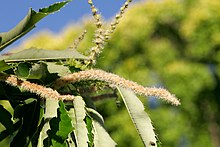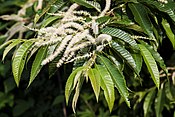
A | B | C | D | E | F | G | H | CH | I | J | K | L | M | N | O | P | Q | R | S | T | U | V | W | X | Y | Z | 0 | 1 | 2 | 3 | 4 | 5 | 6 | 7 | 8 | 9
| Chestnut | |
|---|---|

| |
| Sweet chestnut (Castanea sativa) | |

| |
| The edible nut being sold at a market | |
| Scientific classification | |
| Kingdom: | Plantae |
| Clade: | Tracheophytes |
| Clade: | Angiosperms |
| Clade: | Eudicots |
| Clade: | Rosids |
| Order: | Fagales |
| Family: | Fagaceae |
| Subfamily: | Quercoideae |
| Genus: | Castanea Mill. |
| Species | |
The chestnuts are the deciduous trees and shrubs in the genus Castanea, in the beech family Fagaceae. The name also refers to the edible nuts they produce.[1][2][3] They are native to temperate regions of the Northern Hemisphere.
Description
Chestnut trees are of moderate growth rate (for the Chinese chestnut tree) to fast-growing for American and European species.[4] Their mature heights vary from the smallest species of chinkapins, often shrubby,[5] to the giant of past American forests, C. dentata that could reach 60 metres (200 feet). Between these extremes are found the Japanese chestnut (C. crenata) at 10 m average;[note 1] followed by the Chinese chestnut (C. mollissima) at about 15 m, then the European chestnut (C. sativa) around 30 m.[7]
The Chinese and more so the Japanese chestnuts are both often multileadered and wide-spreading,[7] whereas European and especially American species tend to grow very erect when planted among others, with little tapering of their columnar trunks, which are firmly set and massive. When standing on their own, they spread on the sides and develop broad, rounded, dense crowns at maturity.[4] The foliage of the European and American species has striking yellow autumn coloring.[8]

Its bark is smooth when young,[9] of a vinous maroon or red-brown color for the American chestnut,[10] grey for the European chestnut. With age, American species' bark becomes grey and darker, thick, and deeply furrowed; the furrows run longitudinally, and tend to twist around the trunk as the tree ages; it sometimes reminds one of a large cable with twisted strands.[4]

The leaves are simple, ovate or lanceolate, 10–30 cm long and 4–10 cm wide, with sharply pointed, widely spaced teeth, with shallow rounded sinuates between.[11]
The flowers follow the leaves, appearing in late spring or early summer[4] or into July.[5] They are arranged in long catkins of two kinds,[5] with both kinds being borne on every tree.[10] Some catkins are made of only male flowers, which mature first. Each flower has eight stamens, or 10 to 12 for C. mollissima.[12] The ripe pollen carries a heavy, sweet odor[5] that some people find too sweet or unpleasant. Other catkins have these pollen-bearing flowers, but also carry near the twig from which these spring, small clusters of female or fruit-producing flowers. Two or three flowers together form a four-lobed prickly calybium, which ultimately grows completely together to make the brown hull, or husk, covering the fruits.[4]
Chestnut flowers are not self-compatible, so two trees are required for pollination. All Castanea species readily hybridize with each other.
Fruit
The fruit is contained in a spiny (very sharp) cupule 5–11 cm in diameter, also called "bur" or "burr".[13] The burrs are often paired or clustered on the branch[5] and contain one to seven nuts according to the different species, varieties, and cultivars.[1][2][14][15] Around the time the fruits reach maturity, the burrs turn yellow-brown and split open in two or four sections. They can remain on the tree longer than they hold the fruit, but more often achieve complete opening and release the fruits only after having fallen on the ground; opening is partly due to soil humidity.[16]
The chestnut fruit has a pointed end with a small tuft at its tip (called "flame" in Italian),[16] and at the other end, a hilum – a pale brown attachment scar. In many varieties, the fruit is flattened on one or two sides. It has two skins. The first one is a hard, shiny, brown outer hull or husk, called the pericarpus;[17] the industry calls this the "peel".[16] Underneath the pericarpus is another, thinner skin, called the pellicle or episperm.[17] The pellicle closely adheres to the seed itself, following the grooves usually present at the surface of the fruit. These grooves are of variable sizes and depths according to the species and variety.
The fruit inside these shows a germ with two cotyledons connected to creamy-white flesh throughout.[18] Some varieties have consistently only one embryo per fruit (nut) or have only one large fruit per burr, well rounded (no flat face). The name of varieties with these characteristics may start with "marron"[16] for example marron de Lyon in France, or Marrone di Mugello in Italy.
Chestnut fruit may not exhibit epigeal dormancy. It may germinate right upon falling to the ground in the autumn, with the roots emerging from the seed right away and the leaves and stem the following spring. The germ can lose viability soon after ripening and under drying conditions.
The superior fruiting varieties among European chestnuts have good size, sweet taste, and easy-to-remove inner skins.[19][20] American chestnuts are usually very small (around 5 g), but sweet-tasting with easy-to-remove pellicles. Some Japanese varieties have very large nuts (around 40 g), with typically difficult-to-remove pellicles. Chinese chestnut pellicles are usually easy to remove, and their sizes vary greatly according to the varieties, although usually smaller than the Japanese chestnut.[7]
Similar species
The unrelated horse chestnuts (genus Aesculus) are not true chestnuts, but are named for producing nuts of similar appearance that are mildly poisonous to humans. True chestnuts should also not be confused with water chestnuts, which are tubers of an aquatic herbaceous plant in the sedge family Cyperaceae.[11][18] Other species commonly mistaken for chestnut trees are the chestnut oak (Quercus prinus) and the American beech (Fagus grandifolia),[21][7] both of which are also in the Fagaceae family. Brazil nuts, called "Brasil chestnuts" (castañas de Brasil in Spanish) or "chestnuts from Pará" (castanha-do-Pará in Portuguese) are also unrelated.
Taxonomy
Species
Chestnuts belong to the family Fagaceae, which also includes oaks and beeches. The four main species groups are commonly known as American,[22] European, Chinese, and Japanese chestnuts.
The taxonomy of the American chestnuts is not completely resolved, particularly between the chinkapins (Castanea ozarkensis and Castanea pumila), which are sometimes considered to be the same species. Genetics have indicated the California native "golden chinkapin" (Chrysolepis chrysophylla) is worthy of inclusion in a different genus along with a species from Coastal China. There is also another chestnut, Castanea alabamensis, which may be its own species.[23]
| Subgenus | Image | Scientific name | Common Name | Distribution |
|---|---|---|---|---|
| American chestnuts | 
|
Castanea dentata | American chestnut | Eastern North America |

|
Castanea pumila | American or Allegheny chinkapin, also known as "dwarf chestnut" | Southern and eastern United States[24][16] | |

|
Castanea ozarkensis | Ozark chinkapin | Southeastern and Midwestern United States | |
| Asian chestnuts | 
|
Castanea mollissima | Chinese chestnut | China, Vietnam, India, and North Korea |

|
Castanea henryi | Chinese chinkapin, also called Henry's chestnut | China | |

|
Castanea seguinii | Seguin's chestnut | China | |

|
Castanea crenata | Japanese chestnut, Korean chestnut | Korean Peninsula and Japan | |
| European chestnut | 
|
Castanea sativa | sweet chestnut; also called "Spanish chestnut" in the US and the UK | Parts of Southern Europe, the Caucasus, Western Asia and Asia Minor |
Etymology


The name "chestnut" is derived from an earlier English term "chesten nut", which descends from the Old French word chastain (Modern French, châtaigne).[25] The French word in turn derives from Latin Castanea (also the scientific name of the tree), which traces to the Ancient Greek word κάστανον (sweet chestnut).[26] A possible source of the Greek word is the ancient town of Casthanaea in Magnesia.[27] Its location is at the modern village of Keramidi.[28][29] The town probably took its name, though, from the trees growing around it.[10] In the Mediterranean climate zone, chestnut trees are rarer in Greece because the chalky soil is not conducive to the tree's growth. Kastania is located on one of the relatively few sedimentary or siliceous outcrops. They grow so abundantly there that their presence would have determined the place's name.[30] Still others take the name as coming from the Greek name of Sardis glans (Sardis acorn) – Sardis being the capital of Lydia, Asia Minor, from where the fruit had spread.[31]
The name is cited twice in the King James Version of the Bible. In one instance, Jacob puts peeled twigs in the water troughs to promote healthy offspring of his livestock.[32] Although it may indicate another tree, it indicates the fruit was a local staple food in the early 17th century.[10]
These synonyms are or have been in use: Fagus Castanea (used by Linnaeus in first edition of Species Plantarum, 1753),[33] Sardian nut, Jupiter's nut, husked nut, and Spanish chestnut (U.S.).[4]
Zdroj:https://en.wikipedia.org?pojem=Chestnut
Text je dostupný za podmienok Creative Commons Attribution/Share-Alike License 3.0 Unported; prípadne za ďalších podmienok. Podrobnejšie informácie nájdete na stránke Podmienky použitia.
Antropológia
Aplikované vedy
Bibliometria
Dejiny vedy
Encyklopédie
Filozofia vedy
Forenzné vedy
Humanitné vedy
Knižničná veda
Kryogenika
Kryptológia
Kulturológia
Literárna veda
Medzidisciplinárne oblasti
Metódy kvantitatívnej analýzy
Metavedy
Metodika
Text je dostupný za podmienok Creative
Commons Attribution/Share-Alike License 3.0 Unported; prípadne za ďalších
podmienok.
Podrobnejšie informácie nájdete na stránke Podmienky
použitia.
www.astronomia.sk | www.biologia.sk | www.botanika.sk | www.dejiny.sk | www.economy.sk | www.elektrotechnika.sk | www.estetika.sk | www.farmakologia.sk | www.filozofia.sk | Fyzika | www.futurologia.sk | www.genetika.sk | www.chemia.sk | www.lingvistika.sk | www.politologia.sk | www.psychologia.sk | www.sexuologia.sk | www.sociologia.sk | www.veda.sk I www.zoologia.sk
